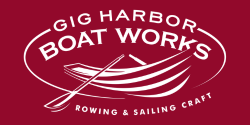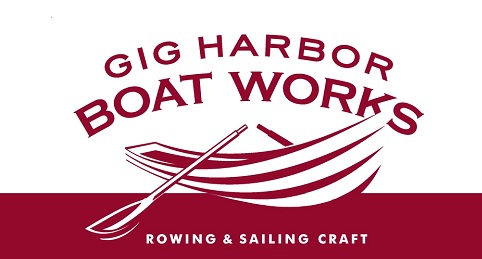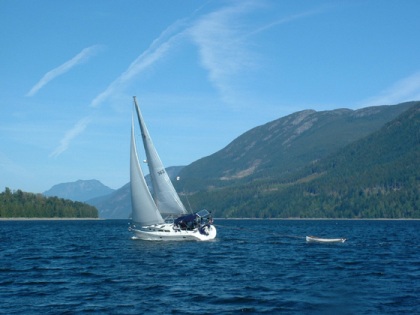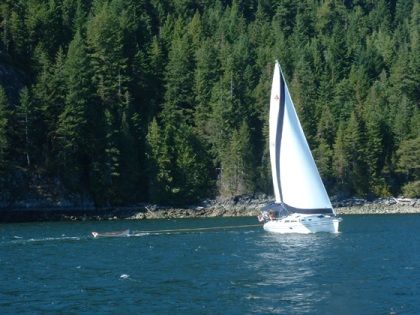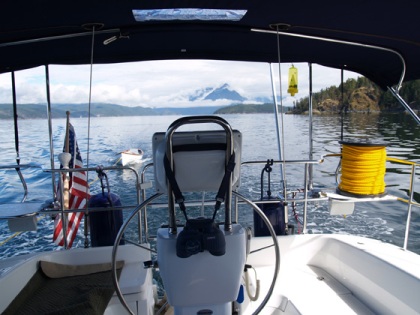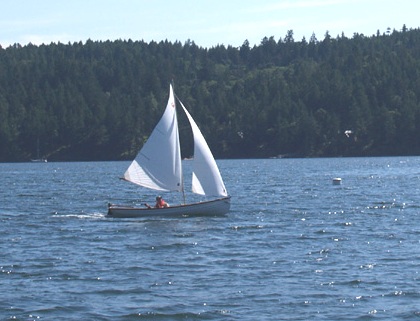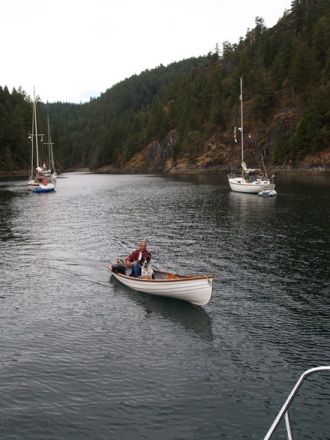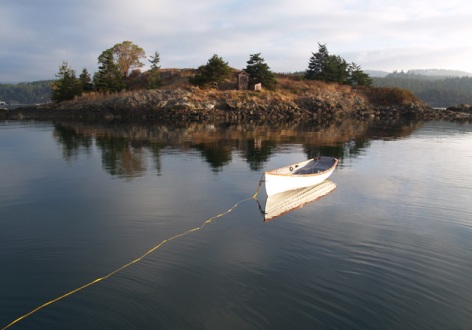Happy Holidays! Autumn here at the boat shop has been busier than usual. Some folks wanted a boat to put under the tree, and well Santa’s workshop can only build them just so fast. We hope that those of you who wake up with this gift truly know how lucky you are that we could make this possible. The end of the new boat line is moving slowly towards the end of the winter as folks start to think about next year’s plans, so if you are in a hurry for a boat, check out the boats that are on the Available Now listings.
As usual this year we will be at the Seattle Boat show. So come on down and check out our boats in person. With this rainy weather it’s a great place to hang out and see what’s new for 2007. The dates are January 25th through Feburary 3rd at the Football stadium event center. The busiest days are of course Saturday, so if you’d like to spend some extra quality time come on down midweek. In addition, if you call or email us beforehand with the date and time of your visit and we can have free tickets waiting for you at Will Call! That’s good for both past and new customers. If you have any photos you’d like to share, please bring them along for our growing collection.
If you want a custom boat for late winter, early spring for that trip to the Caribbean, now is the time to call. We are open Monday thru Friday 9am to 5pm. But if you want a chance to to go out on the water for a test row or sail, please call ahead as we are busy making boats for all our early winter customers. Plus the weather can be iffy in the winter months, and the daylight is limited, so flexibity is key to having a pleasurable on the water boating trial. Contact us to schedule an appointment.
From the Boatshop Mailbag
Our Mailbag again has been overflowing this fall so I’m sure you will enjoy reading about these adventures as much as we have.
US Marines Storm Officers Club
Last summer we sold a nice used Whitehall to the US Marine Corp for a decoration in their officer’s mess at the base on the island of Okinawa. We were skeptical and didn’t really want to do that, as we believe boats belong in the water. They promised us that no damage would be done to the boat, and they’ve kept their word. These photos show some of the alternative uses you can put one of our boats to, dinning room serving table! But we would rather that you go boating. But for our boys in uniform, who are we to deny them some fun.
We expect that with the changing of the guard, this boat will move down to the officer’s boating club, and then back to the States as the officers rotate home. So we look forward to hearing more adventures in boating from these folk.

A nice Starboard reach for a plate.

The down wind run for desert!
Jersey Skiff Heads North
Here is a neat one. We built a dandy 17′ Skiff as a tender for the M.V. Westward, and beautifully restored 1924 yacht. Next week they are heading out for a shakedown in Canada, and then next Spring down to Mexico and then to Polynesia! We wanna go along!
The Westward has a completely rebuilt original 4 cylinder Atlas engine… when I pulled up at the pier the engine was running, just that soft ‘chikka pukka chikka pukka’ coming from the stack. I went into the engine room and the motor was idling at about 110 rpm, watching all the valves ticking over and the giant flywheel turning smooth as glass. -Dave-
Daisy and I delivering the skiff to her new home.
Easy and up she goes.
The attached photo was taken on Thanksgiving morn at Chatterbox Falls in Princess Louisa Inlet (53 deg. 12.3.N / 123 deg. 46.2.W) likely the northeastern range of our fine skiffs foreseeable adventures). All Westward systems sea-trialed well, and we happily rowed the Inlet calms; an inaugural sail must await warmer/breezier days. -Hugh-
Whitehall 14 as Tender
Dave,
My wife bought me the whitehall for our 30th anniversary back in 2002. I think it was finished around February of 2003. You talked me into ordering the sliding seat because in your words “This isn’t a sailboat that rows, it’s a rowboat that sails.” Good advice. A couple of years later we ordered the electric motor package which turned it into a motorboat that sails and rows. It still did not have a name when I took it out for a shakedown cruise with the new motor. The name was selected before I got back to the dock. She is called toyboattoyboattoyboat or toyboat three times fast if you have trouble with the pronunciation.
It was not intended to be used as a tender to our sailboat but I thought it might be fun to tow it up to the San Juan Islands at least once. It has followed us on every cruise since that trip and the thought of cruising without it has never entered my mind since. We’re retired now and have spent three months in the last year and a half cruising in the Canadian Gulf Islands and Desolation Sound. We have also made more trips than I can remember to the San Juans and other local waters. We live on Whidbey Island and have towed her through some huge tide rips and have never had a problem. She rides high and dry and only looks like she may pass us as she surfs down the waves. Our tow rope has grown to about 60 ft in length and that increases my comfort level.
I also sail and row her on the west side of Whidbey through tide rips with total confidence. She handles the waves most impressively. I use her as a fishing boat with the electric motor and have discovered that I can steer with slight weight shift like a surf board and stand up using both hands to fish. The fish feel a lot bigger when you catch them from a small boat. I am considering going after halibut next seaon. Visualize Hemmingway’s “old man and the sea”, I’ll let you know how that works out.
As you can imagine she attracts a lot of attention at the dinghy docks and I always tell people to check out your web site. You make a great line of boats. -Bob-
Towing our Whitehall in a medium breeze.
Tacking inside of the cove.
The Whitehall on a long tow rope.
Sailing in the Gulf Islands.
Motoring with the dogs.
Morning light in the Gulf Islands.
Wow! We hope that when we retire, we’ll be boating here as well.
Hope Island Trip in a Jersey Skiff
Dave,
The water seemed grey and cold as it rushed passed the long concrete ramp at the Harstene Island Bridge. I had to stop and ask myself: Do I really want to do this? Will I be able to get the boat in the water on my own, without banging it against the rocky breakwater on the south side of the ramp? Will I be able to row and sail down to Hope Island while the tide was still in my favor? Would I be able to beach the boat on Hope Island and find a way to secure it so that it was still there, safe, when I woke up the following morning?
This was my second overnight trip in the Mudshark. The first trip was up to Lake Ozette for 3 days. Even though the wind blew like heck, and I sailed it all three days with the main reefed, it was a relatively easy trip. My camping gear . probably weighing in at about 100 pounds – had been lashed down forward of the mast step in dry bags. The winds were westerlies, and it took me a couple of hours to tack my way from Swan Bay to Erickson Bay into the wind. But I had made steady progress. I had no difficulty turning up into Erickson Bay and landing the boat; the water in Ozette is warm, and the beach in Erickson bay is sandy.
But the Hope Island trip was different. Tides, currents, cold water, and some unknowns. I could not remember what the beaches were like on Hope Island (I had been there by kayak about 4 years ago).
I almost turned around and got back into my car without launching the boat. But . . . I didn.t. Actually, the launch, as usual, went smoothly. I even loaded my gear into the boat before kicking the boat off the trailer. The steepness of the ramp helped. I climbed aboard Mudshark, rowed out about 30 feet, and I was taken into the current.
Pickering Passage is relatively narrow, and the winds were light, but directly from the south. I knew that if I raised sail, I would be tacking constantly the whole way, so I kept the oars out and started rowing. I never stopped. Two seals followed Mudshark almost the whole way. Maybe they thought I was fishing and were hoping for a handout. Within about 2 hours, I found myself rowing around the east side of the island (I discovered that this is the wrong side of the island to row on when the tide is rising!). Never mind. I walked in the water and pulled Mudshark the last 100 yards. When I got to the south side of the island, I unloaded my gear and made camp. I used two lines to secure the boat. One was the anchor line, and the other went to a tree on shore. When the tide had reached its highest point around 7:00 PM. I used a block and tackle to move the boat up on to the grass (only about 5 more feet) for the night. I noted that the high tide in the morning, about 6:00 AM, was about 2 feet less than the evening tide, so I knew the boat would be safe.
The island was very quiet. By the time I made dinner, the day visitors had left. I think there was a ranger staying in the cabin, but I didn.t see or hear any signs of human life. I could hear the ubiquitous crows, and across the water, I could hear coyotes. I listened to the weather forecast and read by candlelight for an hour.
The next morning, I was up at 5:30, ate breakfast, and loaded the boat. I easily rolled the boat (on a fender) down the beach a couple feet and we were floating again! I had already loaded the boat . so I climbed in. For the return, I decided to try the west side of the island. I was still a bit . . . befuddled by currents, but I managed to make overall progress as I moved from one isolated rip current to another. Once I got away from the island, the currents became more predictable. As predicted by the weather report the night before, the wind had shifted out of the west and I used the full main and genoa to help me move north towards Harstene Island. The winds were very light, and I found it quite satisfying to keep the sail up and row at the same time, catching breeze pockets and stirrings as I encountered them. The breath of air was just enough to keep the sails and boom on the starboard side, away from my head. As I got closer to the Harstene Island bridge, the wind died completely, and I ended up rowing the last mile without sails. One might guess that I would have been very tired for that last mile. But I wasn.t. I was astounded at how well Mudshark made progress under the oars. True, we had the tide on our side. I had planned it that way. But the GPS showed that we had made great progress/speed under oar over and above what the tides provided. While the Ozette trip tested the boat under fresh breezes and the fickleness and gustiness of lake winds, the Hope Island trip provided an opportunity to challenge the rowing properties of the boat.
As I passed under the bridge, I held my breath. I know that the chart says that the bridge as a clearance of 31 feet. And I know that I made it under the bridge on day before. However, the tide was higher, and I had chosen to pass under the bridge at the end. It sure looked like the mast was going to hit from my perspective, even though I knew there was plenty of room. After passing under, I took a breath and I quickly turned the boat and headed for the ramp. I bumped around a bit on some pilings trying to get into position in the current, but was able to fend off with the oar. Getting the boat out of the water went smoothly.
Boats, as we all know, can be designed with many parameters in mind. One single purpose boat may have one set of parameters and another single purpose boat may have another. I wanted a boat that was more adaptable. And there were not many choices available. The parameters that I had set were not typical of most boaters today:
I wanted a boat that I could use for overnight travel, but at the same time,
I wanted a boat that would never see an internal combustion engine (I am thinking about an electrical motor, however!).
I wanted a boat that I could row for several hours, or all day, for that matter, without completely draining myself and also,
I wanted a boat that could be launched and recovered easily from a trailer without help.
I wanted a boat that could sail reasonably well in a variety of conditions . including upwind when necessary.
I wanted a boat that exemplified simplicity, but at the same time was adaptable and flexible.
I wanted a boat that I could have adventures in, and continue to have adventures in until my desire for adventures was burned out . and at age 52, I have no intention of losing my interest in adventures for a long time.
The Jersey Skiff seems to be the perfect boat to meet my needs! She seems to sail very well. I have not had her out in rough water, but so far she has done well. I think that there was one day in which the winds were up around 20 mph as I returned to the boat launch at Fort Worden and there was a bit of chop. I remember that she was pointing well, but moving rather slowly (the tide and the wind were against me that day). I am also amazed at how well she rowed with all of my gear. On the return trip from Hope Island, my second day in a row of rowing, I felt like we were flying. I think it takes a little longer and a little more effort to get up to hull speed with all of the gear, but once you get there, the momentum is greater. The sliding seat was very helpful. -D. Thielk-
So that’s all the news for now. Thanks to all the folks wrote to tell us about their fall adventures. If you write in and send photos, we’ll be glad to put them up.
We hope to see you at the Seattle Boat Show. And look for our up and coming newsletters!
